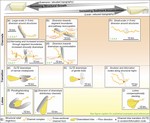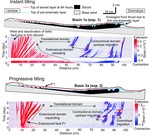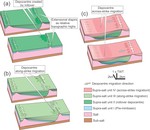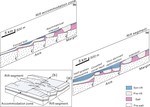Turbidites, Topography and Tectonics: Evolution of Submarine Channel-lobe Systems in the Salt-influenced Kwanza Basin, offshore Angola
We use high quality 3D seismic to document and analysize the evolution of a turbidite system and its interaction with salt-related structures. We show that the growth and decay of salt related structures result in variations in seafloor topography which ultimately controls the routes and depositions of the turbidte system.
Spatial and temporal variations in minibasin geometry and evolution in salt tectonic provinces: Lower Congo Basin, offshore Angola
We use high quality 3D seismic to document the evolution of a network of minibasins and their associated salt-related structures. We show that minibasin initiation and subsequent evolution can be controlled by different mechanisms and therefore categorising minibasins into simple domain-related types is problematic.
Progressive tilting of salt-bearing continental margins controls thin-skinned deformation
Salt-bearing passive margins have different structural styles and kinematic evolution under progressive margin tilting and instant margin tilting,respectively.
Response of unconfined turbidity current to deep‐water fold and thrust belt topography: Orthogonal incidence on solitary and segmented folds
We use numerical simulations to study turbidity current responses, including the hydraulic behaviour and associated deposition, to typical fold and diapir-like topography in deepwater fold and thrust belt.
Minibasin depocentre migration during diachronous salt welding, offshore Angola
We use high‐quality seismic data to show depocentres record minibasin subsidence dynamics and associated salt weld processes. And depocentres can migrate along‐ and across‐strike under the control of salt weld.
Overprinting translational domains in passive margin salt basins: insights from analogue modelling
We use analogue modelling method to demonstrate the issues related to the formation of the translational domain and its evolution during thin-skinned salt tectonic deformation.
Response of unconfined turbidity current to relay‐ramp topography: insights from process‐based numerical modelling
We use numerical simulations to domenstrate how turbidity current responses to typical relay ramp topography in rifts.
Impact of normal faulting and pre‐rift salt tectonics on the structural style of salt‐influenced rifts: the Late Jurassic Norwegian Central Graben, North Sea
We use high quality 3D seismic dataset to demonstarte the interaction between large-scale rift architecture (rift segment vs rift accommodation zone) and complex pre-rift salt-related structures.
Response of unconfined turbidity current to normal‐fault topography
We use numerical simulation to study reactions of turbidity current to typical half-graben scale normal faults in rift basins. We find the fault-related topography has a direct impact upon its flow behaviour and preferential area of deposition.
Salt-structural styles and kinematic evolution of the Jequitinhonha deepwater fold belt, central Brazil passive margin
We use seismic data to study the structural style and kinematic evolution of the Jequitinhonha Basin, Brazil.
Post-rift salt tectonic evolution and key control factors of the Jequitinhonha deepwater fold belt, central Brazil passive margin: Insights from scaled physical experiments
We use analogue modelling to study the structural style and kinematic evolution of thin-skinned salt tectonic deformation in the Jequitinhonha Basin, Brazil.








